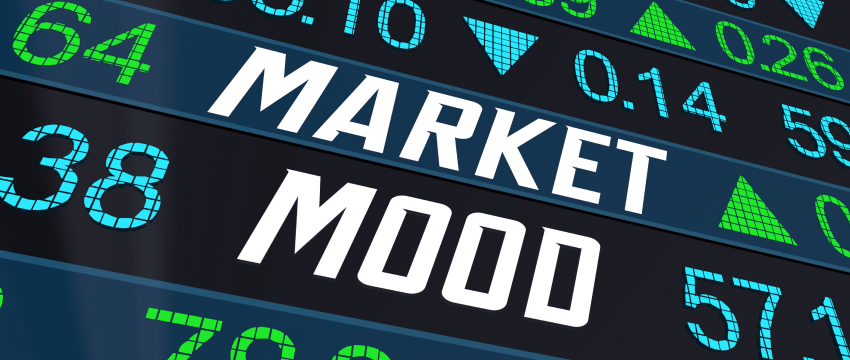What traders feel, from greed to optimism, disappointment or fear falls under what we call market sentiment. Trading sentiment reflects the collective emotion in the market. It helps forex traders understand market dynamics. It also helps them decide if a trend has reached an extreme point. Traders can then assess if it’s time to change direction.
Recognizing trends provides traders with insights allowing them to make better decisions overall. There are many factors that can affect market sentiment, including macroeconomic data, market news, earnings reports, or geopolitical events.
The mood of the market
What traders feel has significant weight and can move the market itself. For example, when the market is upbeat and bullish, the outlook also tends to be positive. When the market is down due to negative data or disappointing news, sentiment usually turns gloomy.
When the market is positive, investors feel confident about the economy. Prices tend to go up. Traders buy more risky assets. In a bearish market, traders often feel gloomy. Prices usually go down. Pessimistic traders may sell currencies they see as risky. This selling pushes the currency prices even lower.
Traders use indicators and price action to measure the market outlook. Another thing that is noteworthy is the fact that market sentiment is different from fundamental and technical analysis. Sentiment involves how market participants feel, whereas analysis is based on data and figures.
What influences sentiment?
Market sentiment is influenced by financial releases, news, media and indicators that could sway traders’ opinion towards a certain direction.
When a macroeconomic indicator is released, such as GDP or PMI, it gives traders useful information. It tells them about a country’s economy. It shows how well a sector is performing. Also it reveals how much the economy has expanded.
If the news is bad, forex traders become more pessimistic. But if the data is better than expected, traders feel good about the economy. As a result, they expect prices to go up.
Central bank decisions are also influential. The same goes for geopolitical events such as wars, pandemics, elections and other global news that may affect the markets.
Technical indicators also influence traders’ decisions about future movements as they reveal price trends, trading volume, and can detect chart patterns that can guide their decisions and change opinion.

Collective emotions of the market
The way traders feel can reveal a lot about how upbeat they feel regarding the state of the global economy, their concerns and worries about where an asset is heading or how confident they are about the forex market. When traders feel optimistic, prices tend to rise, but when they feel worried, they sell assets, pushing prices down.
For example, when the global economy is slowing down and experiencing a contraction, traders tend to find safety away from riskier assets which they tend to sell and move towards the JPY, greenback and Swiss franc which are considered safe-haven currencies.
News impacting sentiment
News and social media platforms can influence the way traders feel by releasing information that can affect opinions, shape views or even manipulate the way traders see things.
Important news can cause traders to overreact or become overtly optimistic or feel disappointed. Social media commentary and public opinions can further intensify sentiment, mislead, influence, spread disinformation and trigger emotional responses.
This is why traders should always research and confirm views and opinions, to ensure that what they are perceiving does reflect the overall sentiment and not the isolated opinion of one trader or individual.
How do traders measure sentiment?
Surveys and Polls
- Consumer Confidence Index (CCI): consumer sentiment
- Investor Sentiment Surveys
- University of Michigan Consumer Sentiment Index
Market Sentiment Indicators
- Fear and Greed Index: measures fear and greed.
- Market Volatility Index (VIX): measures future volatility.
- Put/Call Ratio: shows investor sentiment.
- MOVE Index: implied volatility of the U.S. Treasury options and shows sentiment about interest rate fluctuations and bond market stability.
Technical Analysis Tools
Moving Averages
Stocks Above/Below 200 DMA:
Shows how many stocks are trading above or below their 200-day moving average, showing market strength or weakness.
Relative Strength Index (RSI):
Shows if an asset is overbought or oversold.
Can you trade on market sentiment alone?
The best way is to integrate sentiment analysis into your strategy and use it in combination with other forms of analysis like technical or fundamental analysis.
By forex trading on just sentiment can be risky and misleading as it is not based on hard data. A combination of market sentiment with other forms of analysis can help traders make better and more effective decisions.
Potential risks when trading based on market sentiment
Market sentiment can lead to rash decisions. Traders may also react to news, creating more volatility and sudden moves which may cost them. Sentiment indicators may also mislead traders and trade based on false readings.
Other potential risks are the spread of rumours through social media, which we mentioned above, could lead to false opinions and bad trades. When many traders follow sentiment, they can find it difficult to execute trades due to low liquidity.
Following others’ opinions, reacting impulsively and focusing on the short-term can lead to losses. Furthermore, some traders may feel anxious as a result of having to monitor sentiment all the time, which may affect their capacity for clear and rational decision-making.

Strategies based on market sentiment
Trend following: traders follow the dominant sentiment until there is a reversal.
Contrarian trading involves traders taking positions that go against the general consensus, buying when it’s too pessimistic and selling when it’s too optimistic.
In order to forecast trend reversals, traders search for extremes in sentiment indicators, such as an excessively high VIX or put/call ratio.
What influences sentiment across markets?
Sentiment in forex trading can be impacted macroeconomic data, interest rates, and central bank decisions. In stocks, earnings, news and economic indicators can impact sentiment. Supply and demand as well as trade conditions can impact commodities.
While sentiment in different markets can be affected by various factors, sentiment itself can also impact trades, especially those that are held for shorter periods.
Sentiment can affect short-term trades more than long-term trades as traders can follow changes in market sentiment, whereas when holding longer-term positions fundamentals take a more dominant role.
What resources can I rely on when gauging market sentiment?
No matter what information you are reading and what resources you are using, you should always ensure that these are of quality and well-respected by market participants.
Avoid relying on sketchy websites and the opinion of traders in isolated forums. Instead use media outlets that are globally recognised such as Bloomberg, Reuters, BBC, the Guardian, CNBC and more so you get the latest and most accurate news releases. By integrating sentiment analysis into their trading, traders can inform their decisions and make more effective trades.
The more information you can access and the more types of analysis you can master, the more well-informed you will be and the more capable to grasp market dynamics.
By understanding forex market sentiment, traders can develop strategies that respond to market sentiment and the real reasons behind it.
免责声明: This material is for general informational and educational purposes only and should not be considered investment advice or an investment recommendation. T4Trade is not responsible for any data provided by third parties referenced or hyperlinked in this communication.




